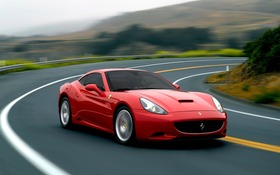2014 Ferrari California: Special Handling Package

| Strong points |
|
|---|---|
| Weak points |
|
How does one pigeon-hole the California, Ferrari's most blatant attempt at mainstream consumerism? Is it pedestrian? No, that makes the gorgeous, two-door hardtop convertible sound too much like a Camry and no Toyota has ever engendered so much lust (from the boys) and admiration (from the female set) as this Ferrari.
Civilized? Well, that might be a slightly more apt descriptor, but then anything that slams to 100 kilometres an hour in under four seconds and tops out at more than 310 km/h is not exactly a Sunday-drive-to-meeting station wagon.
- Also: Ferrari to Start Turboing Their Cars
- Also: Ferrari’s Upcoming Turbocharged Era: Meet The 488 GTB
Indeed, in the three years since it was introduced, the motoring press has struggled to capture the essence of the California. Indeed, what single word would you use to describe that perfect mythical lover; you know, the kind that exudes never-ending sexual tension, yet engenders none of the seemingly endless drama that is the reason no one ever really marries the “one that got away.”
Many of my fellow autoscribes have attempted to classify the new California as the “non-enthusiast’s” Ferrari, but then one hollow, sharp-edged BLATT! from the cross-plane crankshafted, 4.3-litre V8’s twin exhaust pipes while driving through a concrete tunnel puts paid to that silliness. Especially when you’re letting its 483 (up 30-hp for 2013) prancing horses have their head and the walls of said tunnel are flashing by blindingly fast.
The reason for all this dictional angst is that the new California is amazingly, if not completely, devoid of the foibles that are supposed to be the penalty of being rich enough to afford a Ferrari. Ever since Enzo Ferrari first started producing road cars in 1947, Ferraris have exacted a price beyond simple dollars and cents for their four-wheeled magic. In the early days, all those orgiastic multiple carburetors needed constant fettling. Brakes sometimes didn’t. Comfort was of the “it fits Guiseppe, it’ll have to fit you” variety.
In more recent times, electronic fuel injection and the discovery by the Italians of functioning air conditioning systems (will miracles never cease) put most of those old issues to bed. But, of course, Ferrari invented some new ones like the first of its paddle-shifting manumatic transmissions that fried clutches and felt like someone was slamming a telephone book into the back of your head every time you upshifted at full throttle.
Which brings us to the California and my struggle for a single word to describe sexiness without spectacle, passion without turmoil and Ferraris without quirks. For the California is something new altogether (and not necessarily welcomed by card-carrying Tifosi who often see these traditional shortcomings as rights of passage), a product from Modena that is no more difficult to put up with than an Acura.
It has a functioning navigational system, for instance, with nary an electronic foible that one might expect of something both digital and Italian. The same LCD screen turns into a display for the rear-racing backup camera that is accompanied by a – when did the Italians become so politically-correct – truck-like beep to alert that, well, you’re backing up. There’s even a high-tech TFT instrument panel that allows the driver to select the information – engine temperature, etc. – that they want displayed.
The hardtop roof collapses in a perfectly orchestrated, 14-second mechanical plié and, truly, will wonders never cease; the California has more roof-stowed cargo space than many other hard-topped convertibles. Gadzooks! The Italians offering an automobile as practical as the Japanese? Okay, it costs four times as much ($234,900 may be cheap for a Ferrari nut it is not cheap), but surely we should be looking for locusts.
And the car is just so drivable. The steering, for instance, is amazingly light. My mother, anybody's mother really, could wheel the California around a Longo’s parking lot with nary a problem. I thought I had found a foible when the transmission's automatic mode started holding onto gears too long causing the engine to rev far higher than necessary. But then I flicked the steering-wheel mounted Manettino (that controls everything from the traction control system to the transmission shifting patterns) knob from “sport” to “comfort” and lo and behold, the seven-speed dual-clutch trannie became as smooth-shifting and civilized as a Lexus.
On the other hand, of course, the California is a Ferrari. So, when you start paddle-shifting the Getrag-sourced gearbox, the shifts come very quickly (taking but an almost-imperceptible 20 milliseconds), important with an engine that seems to rev to 8,000 rpm at the blink of the proverbial eye.
For, do not be fooled by all this talk of docility and civil comportment, the California is still very much a Ferrari which means what it is best at is getting you all hot and bothered, making you write bad cheques and leaving you – gasping and clutching – trying to explain to your new friends, les gendarmes, why, oh why, temptation was impossible to resist.
Since I didn’t manage to convince the good folks at Ferrari North America that an afternoon fling around Mosport would be good for my karma, I can’t tell you whether the new California has captured all of the traditional handling characteristics of a front engined (actual front-amidships) grand tourismo that has long been a part of Ferrari’s repertoire. I don’t know if it will be faster around a racetrack than a Porsche 911 or even a Corvette ZR1 though with a new Handling Speciale package (stiffer springs, magneto-reheological dampers and a quicker ratio steering box) on offer, the California will almost assuredly corner more adroitly. Nor can I be absolutely certain that the immensely-powerful carbon-ceramic brakes are as fade-free as advertised.
But, like absolutely every single Ferrari I’ve ever driven, it makes me want to find out.











